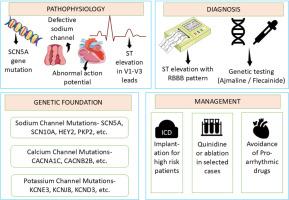解码Brugada综合征:病理生理学、遗传学基础和先进临床管理的综合分析
引用次数: 0
摘要
背景心源性猝死与一种常染色体显性心脏病Brugada综合征(BrS)有关。它的另一个名称是夜间猝死综合征,这是一种新的心律失常疾病,由于其复杂的病理生理和潜在的医学应用而引起了人们的关注。BrS通常被认为是一种相当罕见的疾病,估计全球频率为0.05%,模式为0.4%。报告的BrS患病率从2000年的1 / 5000到1 / 5000不等。目的全面了解Brugada综合征的病理生理、遗传基础、诊断标准和治疗方法。方法对目前的研究进行叙述性综合,重点是流行病学、电生理过程、遗传改变(特别是SCN5A)和临床管理技术,包括风险分层工具和治疗方式。结果brs在世界范围内的患病率估计在2000 / 1至5000 / 1之间。基因突变,尤其是影响心脏钠通道的基因突变,提供了致心律失常的底物,导致独特的ECG异常。诊断是由修订的临床标准和电生理结果驱动的。治疗包括使用植入式心律转复除颤器(icd)和药物治疗。结论brugada综合征是一种复杂的心脏疾病,需要标准化的诊断技术和专门的治疗方案。未来的研究应集中在加强基因筛查、风险预测模型和开发量身定制的药物来降低心源性猝死风险。本文章由计算机程序翻译,如有差异,请以英文原文为准。

Decoding Brugada syndrome: A comprehensive analysis of pathophysiology, genetic foundations and advanced clinical management
Background
Sudden cardiac death is linked to the hereditary condition known as Brugada syndrome (BrS), an autosomal dominant heart illness. Another name for it is sudden nocturnal death syndrome, a novel arrhythmogenic condition that has drawn attention because of its intricate pathophysiology and potential medical applications. BrS is generally considered a fairly uncommon condition, with an estimated 0.05 % global frequency and 0.4 % pattern. The reported prevalence of BrS ranges from 1 in 2000 to 1 in 5000.
Objective
This study seeks to provide a complete understanding of the pathophysiology, genetic basis, diagnostic criteria, and treatment methods related to Brugada syndrome.
Methods
A narrative synthesis of current research was undertaken, concentrating on epidemiology, electrophysiological processes, genetic alterations (specifically SCN5A), and clinical management techniques, including risk stratification tools and treatment modalities.
Results
BrS has a worldwide prevalence estimated between 1 in 2000 and 1 in 5000 persons. Genetic mutations, especially affecting heart sodium channels, provide an arrhythmogenic substrate resulting in distinctive ECG abnormalities. Diagnosis is driven by revised clinical criteria and electrophysiological results. Management involves the use of implanted cardioverter-defibrillators (ICDs) and medication. Recent findings have clarified genotype-phenotype connections and enhanced patient risk classification
Conclusion
Brugada syndrome is a complicated cardiac illness needing standardized diagnostic techniques and specialized therapeutic options. Future research should concentrate on enhancing genetic screening, risk prediction models, and the development of tailored medicines to lower sudden cardiac death risk.
求助全文
通过发布文献求助,成功后即可免费获取论文全文。
去求助
来源期刊

Health sciences review (Oxford, England)
Medicine and Dentistry (General)
自引率
0.00%
发文量
0
审稿时长
75 days
 求助内容:
求助内容: 应助结果提醒方式:
应助结果提醒方式:


